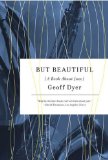Book blurbs often seem the equivalent of movie blurbs. Skepticism seems justified when a publisher puts a blurb smack on the front cover just below the title — especially when it says, “May be the best book ever written about jazz.” Is this honest commentary or gratuitous puffery? With Geoff Dyer’s But Beautiful: A Book About Jazz, it’s the former.
 The concept behind But Beautiful is not unique in and of itself. First published in 1991 and out in a new trade paper edition, it consists of essays about jazz greats Lester “Pres” Young, Thelonius Monk, Bud Powell, Ben Webster, Charlie Mingus, Chet Baker and Art Pepper, with an overarching piece on Duke Ellington traveling between gigs and his songwriting. In execution, though, it is “about jazz” unlike any other book.
The concept behind But Beautiful is not unique in and of itself. First published in 1991 and out in a new trade paper edition, it consists of essays about jazz greats Lester “Pres” Young, Thelonius Monk, Bud Powell, Ben Webster, Charlie Mingus, Chet Baker and Art Pepper, with an overarching piece on Duke Ellington traveling between gigs and his songwriting. In execution, though, it is “about jazz” unlike any other book.
The combination of technical and artistic aspects makes any genre of music hard to write about and leaves little doubt that the variously attributed statement that it’s like “dancing about architecture” is absolutely true. And it’s hard to find a genre with a more complex architecture than jazz, thereby increasing the difficulty of describing it. Dyer, however, does so with sentences that are often strikingly simple yet go right to the heart of the music. For example:
- Monk “played each note as though astonished by the previous one,” often leaving the feeling that “the song seemed to have turned inside out.”
- Mingus’s “bass marched everyone along like a bayonet in a prisoner’s back.”
- “Every time [Baker] played a note he waved it goodbye. Sometimes he didn’t even wave.”
These phrases exquisitely describe an aspect of each musician’s style. Yet the descriptions leave the initiated nodding their head while still giving the uninitiated a sense of the nature of the music. And Dyer also provides longer expositions, such as this passage describing Pepper playing his alto sax while sitting in a prison cell:
For a few moments he falters, oblivious to what he is playing, clutching the eight and ninth rungs of the count. Then, summoning everything, he searches for the highest note, reaches it — just — and soars clear. At the height of this leap, before gravity reasserts itself, there is a moment of absolute weightlessness — bright, clear, serene — before he is falling again, gliding in a gorgeous arc, subsiding into the deep moan of the blues. And the convicts realize that’s what it’s been about all along — a dream of falling.
In a paragraph, Dyer has taken us inside a few seconds of improvisation and both the emotions that helped create it and those it itself created. This is far from the only example in But Beautiful, named after a jazz standard. Over the course of roughly a page, Dyer describes Baker’s style in a way that is nearly as transcendent as its subject.
Yet this alone isn’t what makes the book superb. But Beautiful is a form of literary jazz.
Jazz artists borrow, build upon and expand idioms or concepts of their predecessors and contemporaries. There’s a heavy element of creativity and improvisation as they often go inside a melody to explore, deconstruct or transform it. That is what Dyer does on paper. He seeks the heart of the musicians and their music, blending anecdotes, apocrypha, books and, to a great extent, even photos although only one appears in this edition). Dyer synthesizes these elements into impressionistic essays, something he calls “imaginative criticism.”
Each essay is an extended solo on one artist, at times heavily blues-based. There’s Young awakening to grab a silent phone he thinks is ringing, “expecting to hear someone break the news to him that he had died in his sleep.” There’s Bud Powell, who was “always potentially out of control but now that potential had been unleashed.” But Beautiful explores the toll of genuis and the highs, lows and decimations of people like Powell, Pepper and Baker in ways normal storytelling cannot. But it is not all the ravages of booze, heroin and incarceration. There’s Monk’s inimitable style and him calling his wife Ellie in the middle of a song, leaving the phone off the hook so she can hear what he was playing for her. There’s the creativity and volatility of “Minus, Mingus, Mingus — not a name but a verb, even thought was a form of action, of internalized momentum.” There’s Ellington in a car Harry Carney, a 45-year member of Ellington’s band. As Carney drives, Ellington ponders music and writes songs.
These are just a few of “a whole bunch of guys whose stories and thoughts are not like anyone else’s who wouldn’t have had a chance to express all the ideas and shit they had inside them without jazz.” Dyer’s evocative perceptions of them and their music make But Beautiful “about jazz” in a way that transcends those two words.
Jazz can see things, draw things out of people that painting or writing don’t see.
Geoff Dyer, But Beautiful: A Book About Jazz







